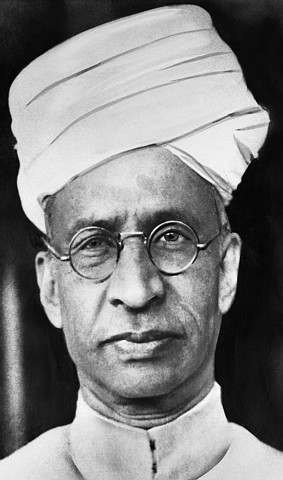Radhakrishnan and Teacher's Day in India
First Online: Sept. 5, 2009 (Teacher's Day) in
Amma's Column
Page Last Updated: December 07, 2024
S. Radhakrishnan (1888-1975) the Great Guru
It was eve of the Republic Day of 1967. (25th of Jan). My husband and myself were listening to the broadcast to the nation by the then President of India over the newly purchased radio set of Philips Maestro II, in Jaipur. Kamat was very much touched by the scholarship farsightedness, concern for his country, ridden with fissiparous tendencies and above all clear voice and fluency in English, high marks of oratory. "Which country in the world today can boast of such a genius as our President?" -- was his spontaneous outburst. Kamat had just returned after a four-year-stay in United States of America and a tour of the European countries. That was the address of Dr. Sarvepalli Radhakrishnan, Second President of the Indian Republic.
Corbis-Bettmann/Kamat's Potpourri
Sarvepalli Radhakrishnan (1888-1975)
Radhakrishnan was a freedom fighter and a great philospher. He serverd as the President of India from 1962-1967
Born in a conservative family of Tiruttani village in Chittor district of Andhra Pradesh in 1888, Radhakrishnan had education in Tirupati, Vellore and finally in Madras. Married at 18, he continued his studies and mastered Sanskrit, Hindi, English, besides his mother tongue Telugu. Topics pertaining to philosophy, education, culture, and literature always attracted him and his attainment in these fields is reflected in all his writings. He established himself as a sound scholar in the field of philosophy at a very young age, and as a teacher par excellence. He taught at several Indian universities and was the first Indian Professor at Oxford, and taught philosophy and ethics.
An authority on comparative religion and ethics, he has several works of international standard to his credit, some of which are 1) The reign of religion in contemporary philosophy 2) Eastern religions and western thought 3) Hindu view of life and 4) Two volumes on Indian Philosophy. He has besides translated into English, Brahmasutras, Upanishads and Bhagavadgita. Many universities bestowed honours and doctorates on him, important amongst them being those of Pennsylvania, Ireland, Teheran and Moscow. Knighthood of England came as early as 1931. He visited several countries, where he was a draw by his tall, slim and stately appearance with his typical dress of immaculate, dhoti, long coat and turban, excellent bearing and oratory. Only two incidents of his popularity as a teacher and his concern as a humanist could be recollected.
Prof. A.N. Moorthy Rao who was a student of Radhakrishnan at Mysore, records an unforgettable event of the send-off given to the learned professor when he accepted Professorship at Calcutta University and was arranging for departure. That day (1920) all the students gathered at Prof. Radhakrishnan's residence and there was no chance for him to meet even his near and dear friends. One group of students took the job of decorating the coach with flowers. Another group went to Railway Station and obtained permission of the stationmaster to decorate the compartment in which their beloved Guru was traveling. Flower garlands were put on the seat, cushions, door & windows. From everywhere the students converged on the railway platform. The horses of the coach which was to take the professor to the Railway Station were unleashed and students themselves pulled the coach, by turns from his residence. There was keen competition to "drive" the master!. There was huge cry of "Radhakrishnanji Ki Jai!" as the train started moving at snail-pace. Many cried. Perhaps the learned professor's eyes also were wet.
This unprecedented send off to a 'commoner' in Maharaja's Mysore left the Railway staff and the commoners flabbergasted. Many years later, when he became Vice-President of India, he fondly recollected the touching farewell to a friend of Mysore. He had exceptional memory and remembered events and students after decades.
He was the only ambassador, the Soviet leader Stalin, had allowed to present his credentials. Prof. Radhakrishnan, was not at all willing to accept this post in a very cold country but Nehru, the Prime minister coaxed him. At the end of the tenure Radhakrishnan, went to the ailing Dictator to bid him farewell. He told Stalin that an emperor in India, after a bloody victory, renounced war and became a monk. (he referred to Ashoka the Great "who knows what may happen to you!" The professor exclaimed. Stalin smiled and said that miracles do happen. He himself had been in a theological seminary for five years! Before parting, Radhakrishnan stroked the back of the great Dictator, and wished him long life. Stalin was very much touched and admitted that here was the first person, who treated him like a human being and not as a monster! He said, "I am sad, you are going. . . . .I have not long to live. . ." He died shortly thereafter.
Many dignitaries who worked with Dr. Radhakrishnan remember his devotion to duty, punctuality, patience, faith in God and man. He was embodiment of Trimurti and academician, writer and statesman put together.
Plato's concept of Philosopher-King was realized in him in a magnified form. He headed the greatest republic. September 5th, the birthday of this great Indian Savant is observed as "Teachers Day". The teacher in ancient Indian context is next only to God.
![]()
